ReferencesReferences
Beetles in the Scarabaeidae
family, dung beetles, chafers. 2011. <URL:
http://www.bumblebee.org/invertebrates/ColeopteraB.htm>
Coleoptera. 2005.<URL:
http://www.cals.ncsu.edu/course/ent425/compendium/coleop~1.html> Accessed 3
April 2011.
Cooke, M.C. 1892. Vegetable wasps and plant worms: a popular history of entomogenous fungi or fungi parasitic upon insects. Society for Promoting Christian Knowledge . pp. 113-116.
Cordyceps.us.
Enshasy, E., Abdel Fattah, H.Y., Atta, A., Anwar, M., Omar, H., Abou El Magd, S. and Zahra Abou, R. 2008. Kinetics of cell growth and Cyclosporin A production by Tolypocladium inflatum when scaling up from shake flask to bioreactor. Journal of Microbiology and Biotechnology 18(1): 128-134.
Hodge Lab of systematics and evolution of fungi. 2006.
<URL:
http://www.plantpath.cornell.edu/Labs/Hodge/G-tolypocladium.html>
Hodge, K.T., Krashoff, S.B. and Humber, R.A. 1996. Tolypocladium inflatum is the anamorph of Cordyceps subsessilis. Mycologia 88(5): 715-719.
Mushroaming.
2010. <URL:
http://www.mushroaming.com/>
Accessed 3 April 2011.
Mycologue Publications. <URL:
http://www.mycolog.com/>
Nicolgou, K.C. and Montagnon, T. 2008. Molecules that changed the world: A brief history of the art and science of synthesis and its impact on society. WILEY-VCH Verlag Gmb ltd. and co. Weinheim, Germany.
Petch, T. 1937. Notes on entomogenous fungi. Transactions
of the British Mycological Society. pp. 34-67. Phyla Ascomycota and
Deuteromycota. 2007.
Phyla Ascomycota and Deuteromycota. 2007.
<URL:http://www.clt.astate.edu/mhuss/phylum_ascomycota.htm>
Accessed 2 April 2011.
Polovinko, G.P., Yaroslavtseva, O.N., Teshebaeva, Z.A. and Kryukov, V.Y. 2010. Dominating species of entomophilus ascomycetes anamorphs in West Siberia, Primorsky Krai, and Kyrgyzstan. Contemporary Problems of Ecology 3(5): 515-521.
Rusnak, F., and Mertz, P. 2000. Calcineurin: form and
function. Physiol Rev. 4.<URL:
http://www.ncbi.nlm.nih.gov/pubmed/11015619>
Segelken, R. 1996. Cyclosporin mold’s ‘sexual state’ found in New York forest: Cornell students’ discovery could target additional sources of nature-based pharmaceuticals. Cornell University Science News. http://www.news.cornell.edu/releases/Sept96/cyclosporine.hrs.html.
Sung, G.H., Hywel-Jones, N.L., Sung, J.M., Luangsa-ard, J.J., Shrestha, B. and Spatafora, J.W. 2007. Phylogenetic classification of Cordyceps and the clavicipitaceous fungi. Studies in Mycology 57: 5-59.
Survase, S.A., Uday, S.A. and Singhal, R.S. 2010. Gellan gum as immobilization matrix for production of Cyclosporin A. Journal of Microbiology and Biotechnology 20(7): 1086-1091.
Upton, H. 2001. Origin of drugs in current use: the
cyclosporin story. World of Fungi. <URL:http://www.world-of-fungi.org/Mostly_Medical/Harriet_Upton/Harriet_Upton.htm>
Zhang, N., and Sung, G.H. 2008. Sordariomycetes. The Tree of Life Web Project. < URL: http://www.tolweb.org/Sordariomycetes/29050> Accessed 2 April 2011.
